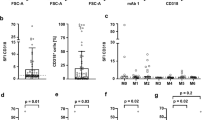Abstract
The aims of this study were to investigate the frequency and prognostic relevance of CD56 expression in patients with acute myeloid leukemia (AML) and to compare the importance of CD56 expression with standard prognostic factors, such as age, leukocytosis, cytogenetic abnormalities and performance status. We analyzed the data of 184 newly diagnosed patients with non-promyelocytic AML and a follow-up of 36 months. The median patient age was 58 years, with a range of 18–79. CD56+ antigen was recorded in 40 patients (21.7%). CD56 + was the most significant risk factor for OS: P = 0.05. The most significant factor for a poor rate of CR was age ≥ 55 years (P = 0.001). CD56 positivity had no significant influence on CR rate, but it was the most significant risk factor for disease-free survival (P = 0.005). The CD56 antigen is an independent prognostic risk factor, and its presence should be measured regularly for a better prognostic assessment of patients with AML.







Similar content being viewed by others
References
Chang H, Salma F, Yi Q, Patterson B, Brien B, Minden MD. Prognostic relevance of immunophenotyping in 379 patients with acute myeloid leukemia. Leuk Res. 2004;28:43–8.
McCulloch EA, Kellecher CA, Miauchi J, Wang C, Cheng GYN, et al. Heterogeneity in acute myeloblastic leukemia. Leukemia. 1988;2(Suppl 12):36s–49s.
Raspadori D, Damiani D, Lenoci M, Rondeli D, Testoni N, et al. CD56 antigen expression in acute myeloid leukemia identifies patients with poor prognosis. Leukemia. 2001;15:1161–4.
Ciolli S, Leoni F, Nozzoli C, Longo G, Gianfaldoni G, et al. Prognostic impact of CD56 in 141 cases of acute myeloid leukemia. Haematologica. 2001;86(Suppl 10): a17 (abstract).
Di Bona E, Sartori R, Zambello R, Guercini N, Madeo D, Rodighiero F. Prognostic significance of CD56 antigen expression in acute myeloid leukemia. Haematologica. 2002;87:250–6.
Reuss-Borst MA, Steinke B, Waller HD, Buhring HJ, Muller CA. Phenotypic and clinical heterogeneity of CD56-positive acute nonlymphoblastic leukemia. Ann Haematol. 1992;64:78–82.
Dunphy CH, Gregowicz AJ, Rodriguez G. Natural killer cell acute leukemia with myeloid antigen expression. A previously undescribed form of acute leukemia. Hematopathology. 1995;104:212–5.
Cheson BD, Bennet JM, Kopecky KJ, Buchner T, Willman CL, et al. International Working Group for diagnosis, standardization of response criteria, treatment outcomes, and reporting standards for therapeutic trials in acute myeloid leukemia. Revised recommendations of the international working group for diagnosis, standardization of response criteria, treatment outcome, and reporting standards for therapeutic trials in acute myeloid leukemia. J Clin Oncol. 2003;21:4642–9.
Bennet JM, Catovsky D, Daniel MT, Flandrin G, Galton DA, et al. Proposals for the classification of the acute leukaemias. French–American–British (FAB) co-operative group. Br J Haematol. 1976;33:219–28.
Donner H, Estey EH, Amadori S, Appelbaum FR, Büchner T, et al. Diagnosis and management of acute myeloid leukemia in adults: recommendations from an international expert panel, on behalf of the European LeukemiaNet. Blood. 2010;115:454–74.
Jiang A, Jiang H, Branddwein J, Kamel-Reid S, Chang H. Prognostic factors in normal karyotype acute myeloid leukemia in absence of the FLT3-ITD mutation. Leuk Res. 2010. doi:10.1016/j.leukres.2010.07.021.
Raspadori D, Damiani D, Micheli M, Stocchi R, Gentili S, et al. CD56 and PGP expression in acute myeloid leukemia: impact on clinical outcome. Haematologica. 2002;87:1135–40.
Breccia M, Frustaci AM, Cannella L, Stefanizzi C, Latagliata R, et al. Comorbidities and FLT3-ITD abnormalities as independent prognostic indicators of survival in elderly acute myeloid leukemia patients. Haem Oncol. 2009;27:148–53.
Klepin HD, Baldalucci L. Acute myelogenous leukemia in older adults. Oncologist. 2009;14:222–32.
Fernandez HF. New trends in the standard of care for initial therapy of acute myeloid leukemia. ASH Education Book. 2010;2010:56–61.
Lowenberg B. Acute myeloid leukemia: the challenge of capturing disease variety. ASH Education Book. 2008;2008(1):1–11.
Bear MR, Stewart CC, Lawrence D, Arthur DC, Byrd JC, et al. Expression of the neural cell adhesion molecule 56 is associated with short remission duration and survival in acute myeloid leukemia with t(8:21) (q22:q22. Blood. 1997;90:1643–8.
Erba HP. Prognostic factors in elderly patients with AML and the implications for treatment. ASH Education Book. 2007;2007(1):420–8.
Kantarjian H, O’Brien S, Cortes J, Giles F, Faderl S, et al. Results of intensive chemotherapy in 998 patients age 65 years or older with acute myeloid leukemia or high risk myelodysplastic syndrome: predictive prognostic models for outcome. Cancer. 2006;106:1090–8.
Giles FJ, Borthakur G, Ravandi F, Faderl S, Verstovsek S, et al. The haematopoietic cell transplantation comorbidity index score predictive of early death and survival in patients over 60 years of age receiving induction therapy for acute myeloid leukemia. Br J Haematol. 2007;136:624–7.
Etienne A, Esterni B, Charbonnier A, Mozziconacci MJ, Arnoulet C, et al. Comorbidity is an independent predictor of complete remission in elderly patients receiving induction chemotherapy for acute myeloid leukemia. Cancer. 2007;109:1376–83.
Acknowledgments
This study was supported by the Ministry of Science and Technological Development of Republic of Serbia, N0 41004.
Conflict of interest
The authors report no conflicts of interest. The authors alone are responsible for the content and writing of the paper.
Author information
Authors and Affiliations
Corresponding author
Rights and permissions
About this article
Cite this article
Djunic, I., Virijevic, M., Djurasinovic, V. et al. Prognostic significance of CD56 antigen expression in patients with acute myeloid leukemia. Med Oncol 29, 2077–2082 (2012). https://doi.org/10.1007/s12032-011-0104-9
Received:
Accepted:
Published:
Issue Date:
DOI: https://doi.org/10.1007/s12032-011-0104-9



